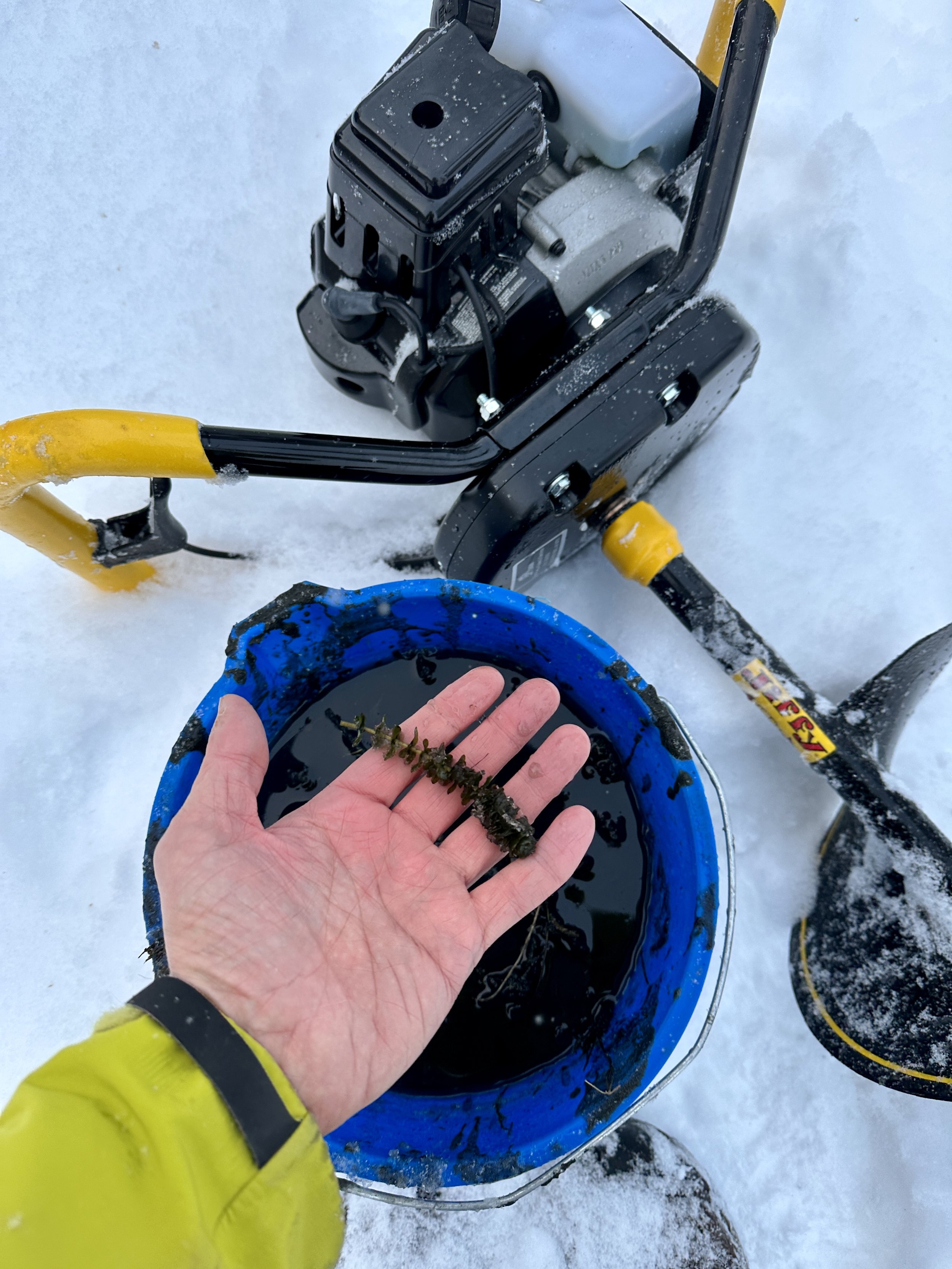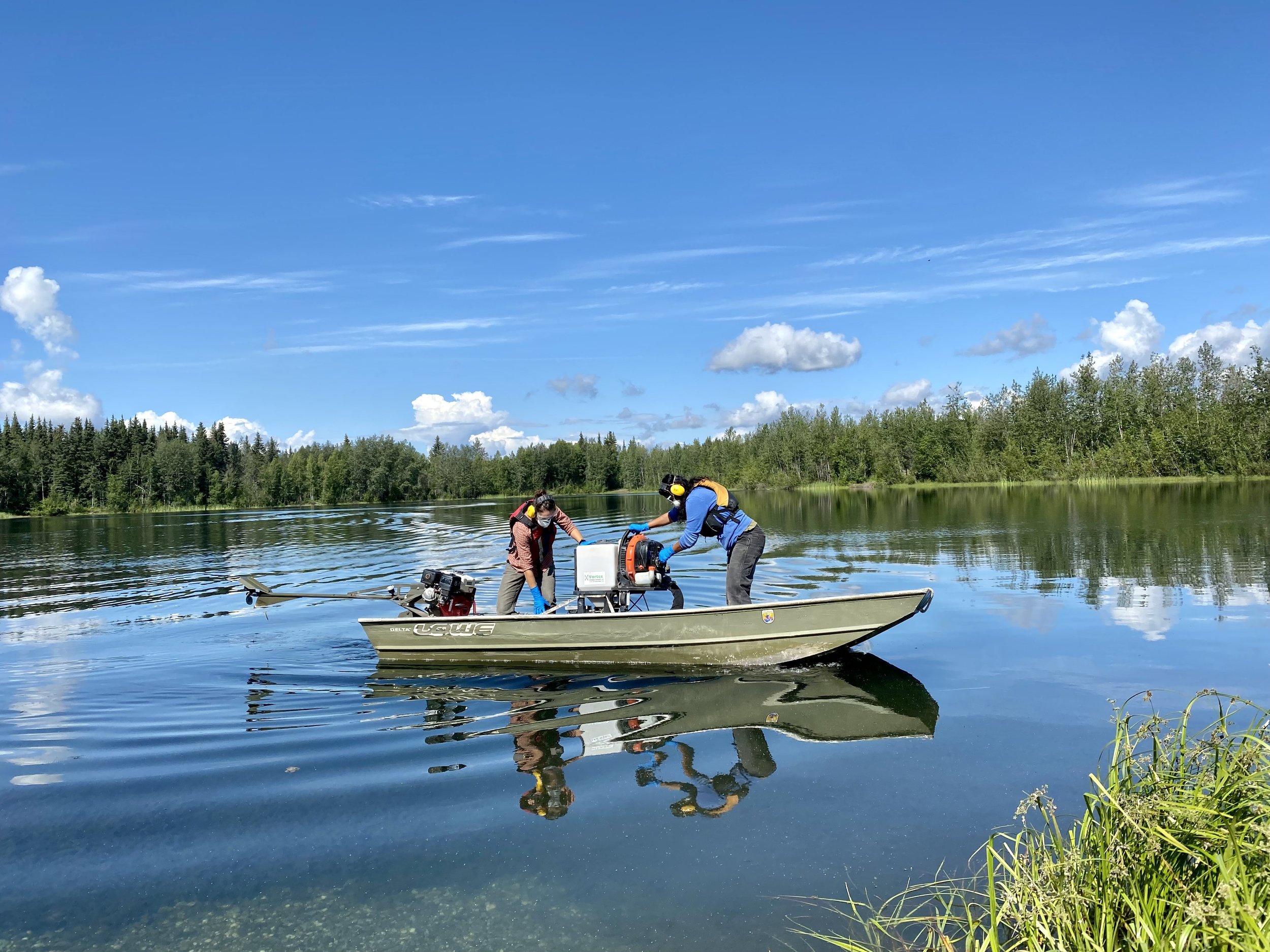Eradication Methods
There is a zero tolerance policy for elodea in Alaskan waterbodies so the end goal of any integrated pest management (IPM) plan is total eradication.
True eradication of species like elodea is generally achieved through the use of aquatic herbicides due to the limitations of mechanical removal methods.
The IPM for Interior Alaska elodea states that the best course of action for sustainable elimination of Elodea is through the use of the aquatic herbicide, Fluridone.
Aquatic Herbicide
The primary herbicide we use to control elodea is Fluridone. We are in a fortunate position where the best chemical for the job is also one that is the least harmful. Fluridone products are generally very safe to handle and are considered ecologically sound for use in Alaskan waters by the Alaska Department of Environmental Conservation (ADEC).
Fluridone is a selective systemic herbicide used for control of aquatic plants. It is absorbed by plant roots and shoots and kills the plant by preventing photosynthesis. Fluridone is effective at killing elodea when applied at 4-8 parts per billion (ppb), but does not affect fish, wildlife, or humans at these low concentrations. Fluridone also has negligible affects on water parameters such as pH, dissolved oxygen, color, dissolved solids, hardness, nitrate nitrogen, total phosphates, and turbidity. Fluridone breaks down naturally through photo-degradation and is not known to persist beyond its intended lifespan in the environment.
According to the US EPA and the State of Alaska, Fluridone poses negligible risks to human health and environment when used according to label instructions. Water treated with Fluridone is safe for swimming, fishing, and drinking below EPA limits of 150ppb. The target concentrations for eradicating elodea ranges from 4-8 ppb of Fluridone. There are no restrictions on swimming, fishing, or drinking during or after the Fluridone treatment.
For more information on the Interior Alaska Elodea Project as well as herbicide use in Alaska, see the links below.
Herbicide Application
Use of the proper application methods as stated on the herbicide label instructions is required under the IPM plan and by law. Use or disposal outside of the label instructions is against the law. Each site we treat with Fluridone or any other herbicide is individually assessed to determine which practices are most suitable.
We generally apply aquatic herbicides via two methods. Solid pellets are used for slow release into a water body over time or a direct liquid application under the waters surface for a more immediate increase in herbicide concentration. The liquid formulation can also be slowly dripped into a waterbody to achieve a more consistent concentration over time. The goal of these methods is to achieve a desired herbicide concentration (generally measured in parts per billion) in the target waterbody.
Pellet Application
The solid pellets are dispersed with an air-powered pellet spreader over the infested area. The pellets are composed of clay, herbicide, and some inactive components and can vary in size depending on the needs of the application site. The pellets are designed to break down slowly and release a small amount of herbicide over an extended period of time.
This application method is considered extremely safe for both the applicator, as well as any plants, animals, and people in the area. The applicator and accompanying technicians tend to wear ear protection due to the sound of the spreader as well as dust masks and eye covers to avoid contact with excessive amounts of clay dust.
Liquid Application
The liquid form of Fluridone is mixed with water in a holding tank prior to application to achieve a desired concentration. Once combined with water it is applied with a pump or sprayer under the surface of the water from a moving boat to ensure adequate mixing and distribution in a waterbody.
This form can also be applied at a slower rate with a stationary drip station. This method is often used in systems where currents inhibit the effectiveness of pellets.
The liquid version of Fluridone has a few more handling precautions than the pellet form due to some of its inactive ingredients that help it stick to the surface of the target plants. Applicators and technicians are required to wear long sleeves, gloves, and eye protection to avoid contact with sensitive tissue.
Early detection and monitoring surveys
One of the best tools we have for controlling elodea in Interior Alaska is the ability to detect infestations early. If an infested waterbody is left unchecked for too long, it becomes a more likely source for a secondary infestation, negatively impacts the overall health of that waterbody, and requires significantly more resources to control than a younger infestation.
The Fairbanks Soil and Water Conservation District (FSWCD) carries out early detection surveys throughout the Interior at high priority sites that are frequently visited by people. These include lakes and ponds stocked for sport fishing, popular fly-in hunting and fishing destinations, waterbodies in close proximity, or downstream of current infestations, and waterbodies with reported elodea sightings.
FSWCD also conducts monitoring surveys of known infested sites to keep tabs on infestation growth, as well as herbicide treatment effectiveness. Monitoring surveys are also used to verify that an elodea infestation has been completely eliminated in the years following the completion of an herbicide treatment program.







